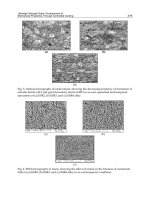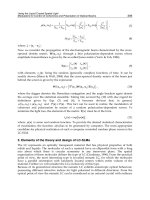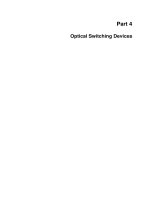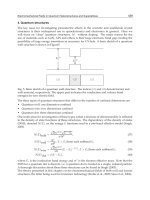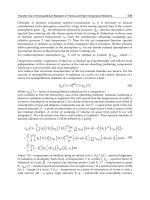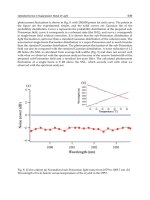Composite Materials Design and Applications Part 12 doc
Bạn đang xem bản rút gọn của tài liệu. Xem và tải ngay bản đầy đủ của tài liệu tại đây (653.86 KB, 29 trang )
(17.22)
Ⅲ The case of a multilayer plate such that for any two plies k and m one
has in the plane of the plate
11
:
Then Equations 17.19 and 17.20 reduce to
(17.23)
The preceding particular cases constitute a severe restriction among the variety
of practical laminations. Nevertheless we will conserve in the following the
simplified forms of Equations 17.21, 17.22, and 17.23 because they well show the
direct connection between the warpings
h
x
and
h
y
and the transverse shear forces
Q
x
and Q
y
, respectively.
17.6.3.2 Consequences
Setting
h
x
and
h
y
in the forms:
(17.24)
The constitutive Equations 17.10 and 17.11 are written as:
Ⅲ
11
Such a limiting case is rare in practice, because it imposes in particular: .
1. cylindrical bending about y axis
G
xz
k
∂
2
h
x
∂
z
2
z
E
11
k
EI
11
E
12
k
EI
12
+
˯
ʈ
Q
x
–=
2. cylindrical bending about x axis
G
yz
k
∂
2
h
y
∂
z
2
z
E
22
k
EI
22
E
12
k
EI
12
+
˯
ʈ
Q
y
–=
E
33
k
E
33
m
G
xy
k
G
xy
m
a
km
==
E
ij
k
E
ij
m
a
km
i and j" 1, 2, 3==
G
xz
k
∂
2
h
x
∂
z
2
z
E
11
k
EI
11
E
12
k
EI
12
+
˯
ʈ
Q
x
–=
G
yz
k
∂
2
h
y
∂
z
2
z
E
22
k
EI
22
E
12
k
EI
12
+
˯
ʈ
Q
y
–=
h
x
x, y, z()
Q
x
hG
xz
·Ò
gz()¥=
h
y
x, y, z()
Q
y
hG
yz
·Ò
pz()¥=
˛
Ô
Ô
˝
Ô
Ô
¸
Q
x
hG
xz
·Ò
∂
w
0
∂
x
q
y
+
˯
ʈ
Q
x
hG
xz
·Ò
G
xz
gd
zd
zd
h/2–
h/2
Ú
+=
TX846_Frame_C17 Page 331 Monday, November 18, 2002 12:33 PM
© 2003 by CRC Press LLC
then by setting :
(17.25)
Ⅲ
then by setting :
(17.26)
There appear two transverse shear coefficients k
x
and k
y
which require the
knowledge of the functions g(z) and p(z) for their calculations.
17.6.4 Warping Functions
Ⅲ Boundary conditions: We have assumed that the upper and lower faces
of the plate were free of any shear. Then the transverse shear in
Equations 17.17 and 17.18 leads to
Ⅲ
then with Equation 17.25:
Ⅲ
then with [17.26]:
Ⅲ Continuity at the interfaces: The continuity of the transverse shear at
the interfaces between layers results from the assumed perfect bonding
between two plies (see Paragraph 15.1.2). One then has at the interface
between two consecutive plies k and k + 1:
k
x
1
1
hG
xz
·Ò
G
xz
gd
zd
zd
h/2–
h/2
Ú
–
˯
ʈ
=
Q
x
hG
xz
·Ò
k
x
∂
w
0
∂
x
q
y
+
˯
ʈ
=
Q
y
hG
yz
·Ò
∂
w
0
∂
y
q
x
–
˯
ʈ
Q
y
hG
yz
·Ò
G
yz
pd
zd
zd
h/2–
h/2
Ú
+=
k
y
1
1
hG
yz
·Ò
G
yz
pd
zd
zd
h/2–
h/2
Ú
–
˯
ʈ
=
Q
y
hG
yz
·Ò
k
y
∂
w
0
∂
y
q
x
–
˯
ʈ
=
∂
w
0
∂
y
q
y
+
˯
ʈ
Q
x
hG
xz
·Ò
dg
dz
+ 0 for zh/2±==
k
x
gd
zd
+ 0 for zh/2±==
∂
w
0
∂
y
q
y
–
˯
ʈ
Q
y
hG
yz
·Ò
dp
dz
– 0 for zh/2±==
k
y
pd
zd
+ 0 for zh/2±==
t
xz
k
t
xz
k+1
;
t
yz
k
t
yz
k+1
==
TX846_Frame_C17 Page 332 Monday, November 18, 2002 12:33 PM
© 2003 by CRC Press LLC
then with Equations 17.17, 17.18 and Equations 17.25, 17.26:
Ⅲ Formulation of the warping functions: Let us substitute to g(z) and
p(z) the functions g
0
(z) and p
0
(z) such that:
g
0
(z) and p
0
(z) are called the warping functions. Then the boundary conditions
and the interface conditions simplify, and Equations 17.23 allow one to formulate
the problems that permit a simple calculation of warping functions g
0
(z) and p
0
(z).
One obtains
(17.27)
(17.28)
The antisymmetric functions g
0
and p
0
are then defined in a unique manner.
17.6.5 Consequences
Ⅲ Form of the transverse shear stresses: Equations 17.17 and 17.18 then
take the simple forms:
(17.29)
G
xz
k
k
x
dg
k
dz
+
˯
ʈ
G
xz
k+1
k
x
dg
k+1
dz
+
˯
ʈ
=
G
yz
k
k
y
dp
k
dz
+
˯
ʈ
G
yz
k+1
k
y
dp
k+1
dz
+
˯
ʈ
=
g
0
z() gz() zk
x
; p
0
¥ z()+ pz() zk
y
¥+==
d
2
g
0
dz
2
z
hG
xz
·Ò
G
xz
k
E
11
k
EI
11
E
12
k
EI
12
+
˯
ʈ
¥–=
dg
0
dz
0 for zh/2±==
G
xz
k
dg
0k
dz
G
xz
k+1
dg
0k+1
dz
for zz
k
==
Ó
Ô
Ô
Ô
Ì
Ô
Ô
Ô
Ï
d
2
p
0
dz
2
z
hG
yz
·Ò
G
yz
k
E
22
k
EI
22
E
12
k
EI
12
+
˯
ʈ
¥–=
dp
0
dz
0 for zh/2±==
G
yz
k
dp
0k
dz
G
yz
k+1
dp
0k+1
dz
for zz
k
==
Ó
Ô
Ô
Ô
Ì
Ô
Ô
Ô
Ï
t
xz
Q
x
G
xz
k
hG
xz
·Ò
dg
0
dz
;
t
yz
¥ Q
y
G
yz
k
hG
yz
·Ò
dp
0
dz
¥==
TX846_Frame_C17 Page 333 Monday, November 18, 2002 12:33 PM
© 2003 by CRC Press LLC
Ⅲ Transverse shear coefficients: One obtains these coefficients from the
Equation 17.5:
Ⅲ
here is :
noting that :
One obtains :
(17.30)
Ⅲ
here is :
leading to:
(17.31)
In summary, in the absence of body forces (inertia forces, example), the
bending behavior uncoupled from the membrane behavior of a thick laminated
plate can be simplified in a few particular cases noted below. The characteristic
relations are summarized in the following table.
Bending Behavior (no in-plane stress resultants)
homogeneous orthotropic plate/orthotropic axes : x, y, z
or Laminated plate/midplane symmetry/orthotropic axes of plies: x,y,z/same
Poisson ratios v
xy
and v
yx
for all plies/cylindrical bending about x or y axis.
or Laminated plate/midplane symmetry/orthotropic axes of plies: x,y,z/elastic
constants are proportional from one ply to another
᭹
Equilibrium relation:
Ú
h/2–
h/2
E
11
EI
11
E
12
EI
12
+
˯
ʈ
h
x
zzd 0=
E
11
EI
11
E
12
EI
12
+
˯
ʈ
Q
x
hG
xz
·Ò
g
0
kz
x
–()¥ zzd
h/2–
h/2
Ú
0=
E
11
EI
11
E
12
EI
12
+
˯
ʈ
z
2
zd
h/2–
h/2
Ú
C
11
EI
11
C
12
EI
12
+
C
11
C
12
C
12
2
–
C
11
C
12
C
12
2
–
1.== =
k
x
E
11
EI
11
E
12
EI
12
+
˯
ʈ
g
0
zzd
h/2–
h/2
Ú
=
Ú
h/2–
h/2
E
22
EI
22
E
12
EI
12
+()
h
y
zzd 0=
E
22
EI
22
E
12
EI
12
+
˯
ʈ
Q
y
hG
yz
·Ò
p
0
kz
y
–()¥ zzd
h/2–
h/2
Ú
0=
k
y
E
22
EI
22
E
12
EI
12
+
˯
ʈ
p
0
zzd
h/2–
h/2
Ú
=
∂
Q
x
∂
x
∂
Q
y
∂
y
p
z
++ 0;
∂
M
y
∂
x
∂
M
xy
∂
y
Q
x
–– 0;
∂
M
xy
∂
x
∂
M
x
∂
y
Q
y
++ 0===
TX846_Frame_C17 Page 334 Monday, November 18, 2002 12:33 PM
© 2003 by CRC Press LLC
᭹
Constitutive relations:
with
᭹
Stresses
Ⅲ stresses within the ply :
s
x
: cf. [17.14];
s
y
: cf. [17.15];
t
xy
: cf. [17.16]
Ⅲ transverse shear stresses
(17.32)
᭹
Warping functions
Ⅲ g
0
(z) is the solution of the problem:
Ⅲ p
0
(z) is the solution of the problem:
᭹
Transverse shear coefficients k
x
and k
y
:
Ⅲ They are given by the formula:
M
y
M
x
–
M
xy
–
Q
x
Q
y
Ó ˛
ÔÔ
ÔÔ
ÔÔ
ÔÔ
ÔÔ
ÔÔ
Ì ˝
ÔÔ
ÔÔ
ÔÔ
ÔÔ
ÔÔ
ÔÔ
ϸ
C
11
C
12
00 0
C
21
C
22
00 0
00C
33
00
000
hG
xz
·Ò
k
x
0
000 0
hG
yz
·Ò
k
y
∂q
y
∂
x
∂q
x
∂
y
–
∂q
y
∂
y
∂q
x
∂
x
–
∂
w
0
∂
x
q
y
+
∂
w
0
∂
y
q
x
–
Ó ˛
ÔÔ
ÔÔ
ÔÔ
ÔÔ
ÔÔ
Ì ˝
ÔÔ
ÔÔ
ÔÔ
ÔÔ
ÔÔ
ϸ
=
C[]
1–
1
EI
=
t
xz
Q
x
G
xz
k
hG
xz
·Ò
dg
0
dz
= ;
t
yz
Q
y
G
yz
k
hG
yz
·Ò
dh
0
dz
=
d
2
g
0
dz
2
z
hG
xz
·Ò
G
xz
k
E
11
k
EI
11
E
12
k
EI
12
+
˯
Á˜
ʈ
–=
dg
0
dz
0= for zh/2±=
G
xz
k
dg
0k
dz
G
xz
k+1
dg
0k+1
dz
= for zz
k
=
Ó
Ô
Ô
Ô
Ô
Ì
Ô
Ô
Ô
Ô
Ï
d
2
p
0
dz
2
z
hG
yz
·Ò
G
yz
k
E
22
k
EI
22
E
12
k
EI
12
+
˯
Á˜
ʈ
–=
dp
0
dz
0= for z h/2±=
G
yz
k
dp
0k
dz
G
yz
k+1
dp
0k+1
dz
= for zz
k
=
Ó
Ô
Ô
Ô
Ô
Ì
Ô
Ô
Ô
Ô
Ï
k
x
E
11
EI
11
E
12
EI
12
+
˯
ʈ
g
0
zz; k
y
E
22
EI
22
E
12
EI
12
+
˯
ʈ
p
0
zzd
h/2–
h/2
Ú
=d
h/2–
h/2
Ú
=
TX846_Frame_C17 Page 335 Monday, November 18, 2002 12:33 PM
© 2003 by CRC Press LLC
17.6.6 Interpretation in Terms of Energy
We will limit ourselves to the surface energy density due to transverse shear stresses
as:
Substituting Equation 17.29, one obtains
The first integral can be rewritten as:
or, taking into account Equation 17.27:
where one recognizes Equation 17.30 of the transverse shear coefficient k
x
, The
first integral is reduced to
Following a similar approach for the second integral and taking into account
Equations 17.28 and 17.31 for the transverse shear coefficient k
y
, the surface energy
due to transverse shear takes the form:
17.7 EXAMPLES
Examples for plates in bending are shown in details in Part Four of this book, in
Chapter 18, “Applications.” We give here a few useful elements to treat these
examples.
W
t
1
2
t
xz
g
xz
t
yz
g
yz
+()zd
h/2–
h/2
Ú
1
2
t
xz
2
G
xz
t
yz
2
G
yz
+
˯
ʈ
zd
h/2–
h/2
Ú
==
W
t
1
2
Q
x
2
G
xz
hG
xz
·Ò
2
g
0
d
zd
˯
ʈ
2
z
1
2
+d
h/2–
h/2
Ú
Q
y
2
G
yz
hG
yz
·Ò
2
p
0
d
zd
˯
ʈ
2
zd
h/2–
h/2
Ú
=
1
2
Q
x
2
hG
xz
·Ò
2
G
xz
d
zd
g
0
g
0
d
zd
˯
ʈ
g
0
d
2
g
0
z
2
d
– zd
h/2–
h/2
Ú
1
2
Q
x
2
hG
xz
·Ò
2
G
xz
g
0
dg
0
dz
h/2–
h/2
hG
xz
·Ò
E
11
EI
11
E
12
EI
12
+
˯
ʈ
g
0
zzd
h/2–
h/2
Ú
+
Ó ˛
Ì ˝
ϸ
1
2
k
x
Q
x
2
hG
xz
·Ò
W
t
1
2
k
x
Q
x
2
hG
xz
·Ò
1
2
k
y
Q
y
2
hG
yz
·Ò
+=
TX846_Frame_C17 Page 336 Monday, November 18, 2002 12:33 PM
© 2003 by CRC Press LLC
17.7.1 Homogeneous Orthotropic Plate
Ⅲ Warping functions: Equation 17.27 becomes
12
Ⅲ Transverse shear stresses and shear coefficients: One deduces from
Equation 17.32:
(17.33)
(17.34)
In an analogous manner starting from Equation 17.28:
then:
(17.35)
(17.36)
Remark: In Application 18.3.7 (Chapter 18), one treats the case of a thick
homogeneous orthotropic plate in cylindrical bending about the y axis. The plate
supports a uniformly distributed load. One can consider there the strong influence
of transverse shear in bending. Two characteristics of the plate then apply directly
on the deflection:
12
g
0
is, as g, antisymmetric in z (see Equation 17.4).
E
11
k
E
11
= ; E
12
k
E
12
; E
22
k
E
22
= ; G
xz
k
= G
xz
=
d
2
g
0
dz
2
zh
E
11
E
22
E
11
E
22
E
12
2
–
12
h
3
E
12
2
E
11
E
22
E
12
2
–
12
h
3
–
˯
Á˜
ʈ
– z
12
h
2
¥–==
dg
0
dz
0 for zh/2±==
then
12
dg
0
dz
3
2
14
z
2
h
2
–
˯
ʈ
; g
0
3
2
z 1
4
3
z
2
h
2
–
˯
ʈ
==
t
xz
Q
x
h
3
2
14
z
2
h
2
–
˯
ʈ
¥=
k
x
12
h
3
3
2
1
4
3
z
2
h
2
–
˯
ʈ
z
2
zd
h/2–
h/2
Ú
=
k
x
6
5
=
p
0
z() g
0
z()=
t
yz
Q
y
h
3
2
14
z
2
h
2
–
˯
ʈ
¥=
k
y
6
5
=
TX846_Frame_C17 Page 337 Monday, November 18, 2002 12:33 PM
© 2003 by CRC Press LLC
Ⅲ The relative thickness h/a, where a is the length of the bent side of the plate
Ⅲ The ratio E
x
/G
xz
(for certain combinations of fiber/matrix, this ratio becomes
large compared with unity; for example, for unidirectional)
17.7.2 Sandwich Plate
The plate consists of two orthotropic materials:
Material (1) for the skins
Material (2) for the core (see Figure 17.3)
Assuming the proportionality of elastic coefficients for the two materials leads
to (see Section 17.6.3):
one deduces from there:
Figure 17.3 Sandwich Plate
then
C
ij
E
ij
z
2
zd
h/2–
h/2
Ú
E
ij
➀
z
2
zd
H
1
/2–
H
2
/2–
Ú
E
ij
➁
z
2
zdE
ij
➀
z
2
zd
H
2
/2
H
1
/2
Ú
+
H
2
/2–
H
2
/2
Ú
+==
C
ij
E
ij
➀
H
1
3
H
2
3
–
12
˯
ʈ
E
ij
➁
H
2
3
12
+=
C
ij
E
ij
➀
a
H
1
3
12
with
a
H
1
3
12
¥
H
1
3
H
2
3
–
12
a
12
+
H
2
3
12
==
1
E
I
11
-
C
11
C
11
C
22
C
12
2
–
E
11
➀
E
11
➀
E
22
➀
E
12
➀
()
2
–
12
a
H
1
3
¥==
1
E
I
12
C
12
–
C
11
C
22
C
12
2
–
E
12
➀
–
E
11
➀
E
22
➀
E
12
➀
()
2
–
12
a
H
1
3
¥==
TX846_Frame_C17 Page 338 Monday, November 18, 2002 12:33 PM
© 2003 by CRC Press LLC
17.7.2.1 Warping Functions
Ⅲ From the above one can write in Equation 17.27
13
:
In addition :
Equation 17.27 then can be written as:
Ⅲ In Equation 17.28, one obtains an analogous formulation. In effect, one
can write
The problem [17.28] is then written as:
Ⅲ Remark: These problems are identical to that which allows the calculation
of the warping function for the bending of a sandwich beam, and one
can consider it in Chapter 18, application 18.3.5. One can then carry out
the same steps of calculation. The results obtained are shown below.
13
See Equations 17.2.
E
11
k
EI
11
E
12
k
EI
12
+
˯
ʈ
E
x
k
E
x
➀
12
a
H
1
3
¥
E
x
k
E
x
➀
H
1
3
H
2
3
–()
12
E
x
➁
H
2
3
12
+
==
hG
xz
·ÒG
xz
➀
H
1
H
2
–()G
xz
➀
H
2
+=
d
2
g
0
dz
2
z–
E
x
k
G
xz
k
12
G
xz
➀
H
1
H
2
–()G
xz
➁
H
2
+
E
x
➀
H
1
3
H
2
3
–()E
x
➁
+ H
2
3
¥¥=
dg
0
dz
0 for zH
1
±/2==
G
xz
dg
0
dz
continuous for zH
2
±/2=
Ó
Ô
Ô
Ô
Ì
Ô
Ô
Ô
Ï
E
22
k
EI
22
E
12
k
EI
12
+
˯
ʈ
E
y
k
E
y
➀
12
a
h
3
¥
E
y
k
E
y
➀
H
1
3
H
2
3
–()
12
E
y
➁
H
2
3
12
+
==
d
2
p
0
dz
2
z
E
y
k
G
yz
k
12
G
yz
➀
H
1
H
2
–()G
yz
➁
+ H
2
E
y
➀
H
1
3
H
2
3
–()E
y
➁
+ H
2
3
¥¥–=
dp
0
dz
0 zH
1
/2±==
G
yz
dp
0
dz
continuous for zH
2
/2±=
Ó
Ô
Ô
Ô
Ì
Ô
Ô
Ô
Ï
TX846_Frame_C17 Page 339 Monday, November 18, 2002 12:33 PM
© 2003 by CRC Press LLC
17.7.2.2 Transverse Shear Stresses
Ⅲ Stress
t
xz
:
(17.37)
Ⅲ Stress
t
yz
:
(17.38)
17.7.2.3 Transverse Shear Coefficients
(17.39)
k
y
is given by an expression formally identical to that in which the index x is
replaced by y.
In Application 18.3.8 we treat the case of a rectangular sandwich plate in
cylindrical bending, clamped on one side and subjected to a uniform linear force
on another. The plate is free on the other sides. One shows the influence of
transverse shear on the deflection. This influence increases when:
Ⅲ The mechanical characteristics (moduli) of the core are weaker than those
of the skins.
Ⅲ The relative thickness of the core is important (thin skins).
Ⅲ The relative thickness of the plate is large (thick plate).
H
2
2
z
H
2
2
££– ;
t
xz
Q
x
6
E
x
➁
H
2
2
4
z
2
–
˯
ʈ
E
x
➀
H
1
2
4
H
2
2
4
–
˯
ʈ
+
E
x
➀
H
1
3
H
2
3
–()E
x
➁
H
2
3
+
¥¥=
H
2
2
z
H
1
2
££ :
t
xz
Q
x
6
E
x
➀
H
1
2
4
z
2
–()
E
x
➀
H
1
3
H
2
3
–()E
x
➁
H
2
3
+
¥¥=
H
2
2
z
H
2
2
££– ;
t
yz
Q
y
6
E
y
➁
H
2
2
4
z
2
–()E
y
➀
H
1
2
4
H
2
2
4
–()+
E
y
➀
H
1
3
H
2
3
–()E
y
➁
H
2
3
+
¥¥=
H
2
2
z
H
1
2
££ ;
t
yz
Q
y
6
E
y
➀
H
1
2
4
z
2
–()
E
y
➀
H
1
3
H
2
3
–()E
y
➁
H
2
3
+
¥¥=
k
x
a
x
8 E
x
➀
H
1
3
H
2
3
–()E
x
➁
H
2
3
+[]
E
x
➁
G
xz
➁
H
2
3
E
x
➀
H
1
2
4
5
E
x
➁
E
x
➀
–
˯
ʈ
H
2
2
+
Ó
Ì
Ï
º=
…
E
x
➀
()
2
G
xz
➀
4
5
H
1
5
H
2
5
5
H
1
2
H
2
3
–+
˯
ʈ
+
˛
˝
¸
3b
x
E
x
➀
H
1
2
H
2
2
–()
E
x
➀
H
1
3
H
2
3
–()E
x
➁
H
2
3
+
+
with a
x
12
G
xz
➀
H
1
H
2
–()G
xz
➁
H
2
+
E
x
➀
H
1
3
H
2
3
–()E
x
➁
H
2
3
+
¥=
b
x
a
x
16
H
2
E
x
➀
G
xz
➀
H
2
2
3
H
1
2
G
xz
➀
G
xz
➁
1–
˯
Á˜
ʈ
+
Ó
Ì
Ï
= H
2
2
G
xz
➀
G
xz
➁
1
2
3
E
x
➁
E
x
➀
–
˯
Á˜
ʈ
–
˛
˝
¸
TX846_Frame_C17 Page 340 Monday, November 18, 2002 12:33 PM
© 2003 by CRC Press LLC
PART IV
APPLICATIONS
We have grouped in this last part of the book exercises and examples for applica-
tions. These have various objectives and different degrees of difficulties. Leaving
aside (except for special cases) the cases that are too academic, we will concern
ourselves with applications of concrete nature, with an emphasis on the numerical
aspect of the results. A few of these applications should be used as validation
tests for numerical models.
TX846_Frame_C18a Page 341 Monday, November 18, 2002 12:40 PM
© 2003 by CRC Press LLC
18
APPLICATIONS
18.1 LEVEL 1
18.1.1 Simply Supported Sandwich Beam
Problem Statement:
1. The following figure represents a beam made of duralumin that is supported
at two points. It is subjected to a transverse load of
F
=
50 daN. Calculate
the deflection—denoted as
D
—of the beam under the action of the force
F
.
2. We separate the beam of duralumin into two parts with equal thickness
e
p
=
2.5 mm, by imaginarily cutting the beam at its midplane. Each half is
bonded to a parallel pipe made of polyurethane foam, making the skins
of a sandwich beam having essentially the same mass as the initial beam
(in neglecting the mass of the foam and the glue). The beam is resting
on the same supports and is subjected to the same load
F
. Calculate the
deflection caused by
F
, denoted by
D¢
. Compare with the value of
D
found
in Part 1. (Take the shear modulus of the foam to be:
G
c
=
20 MPa.)
Solution:
1. We will use the classical formula that gives the deflection at the center of
the beam on two supports:
D
F
48EI
with I
bh
3
12
==
TX846_Frame_C18a Page 343 Monday, November 18, 2002 12:40 PM
© 2003 by CRC Press LLC
For duralumin (see Section 1.6):
E
=
75,000 MPa. One finds
2. Denoting by
W
the elastic energy due to flexure, one has
1
with
2
:
Using Castigliano theorem, one has
then:
Approximate calculation:
then:
1
To establish this relation, see Chapter 15, Equation 15.17.
2
See calculation of this coefficient in 18.2.1, and more precise calculation in 18.3.5.
D 16.7 mm=
W
1
2
M
2
EI·Ò
x
1
2
k
GS·Ò
T
2
xd
beam
Ú
+d
beam
Ú
=
k
GS·Ò
#
1
G
c
e
c
2e
p
+()b¥
D¢
∂
W
∂
F
=
D¢
M
EI·Ò
dM
Fd
x
k
GS·Ò
T
Td
Fd
xd
beam
Ú
+d
beam
Ú
=
0 x ᐉ/2: M££ Fx/2; TF/2–==
ᐉ/2 x ᐉ: M££
F
2
ᐉ x–(); TF/2==
D¢
1
EI·Ò
Fx
2
x
2
¥ x
F
2
ᐉ x–()
ᐉ x–()
2
x
º
d
ᐉ/2
ᐉ
Ú
+d
0
ᐉ/2
Ú
Ó ˛
Ì ˝
ϸ
=
º
k
GS·Ò
F
2
xd
2
–¥–
F
2
xd
2
¥
ᐉ/2
ᐉ
Ú
+
0
ᐉ/2
Ú
Ó ˛
Ì ˝
ϸ
+
D¢
Fᐉ
3
48 EI·Ò
Fᐉ
4
k
GS·Ò
+=
EI·Ò # E
p
e
p
b
e
c
e
p
+()
2
2
E
c
e
c
3
b
12
¥+¥¥¥
EI·Ò 7090 MKS 7.8
MKS
negligible
with E
c
+ 60 MPa cf. 1.6()==
TX846_Frame_C18a Page 344 Monday, November 18, 2002 12:40 PM
© 2003 by CRC Press LLC
one obtains for D¢:
Comparing with the deflection D found in Part 1 above:
Remarks:
Ⅲ The sandwich configuration has allowed us to divide the deflection by 14
without significant augmentation of the mass: with adhesive film thickness
0.2 mm and a specific mass of 40 kg/m
3
for the foam, one obtains a total
mass of the sandwich:
m = 700 g (duralumin) + 50 g (foam) + 48 g (adhesive)
This corresponds to an increase of 14% with respect to the case of the full beam
in Question 1.
Ⅲ The deflection due to the shear energy term is close to 6 times more
important than that due to the bending moment only. In the case of the
full beam in question 1, this term is negligible. In effect one has:
k = 1.2 for a homogeneous beam of rectangular section, then:
(with G = 29,000 MPa, Section 1.6). The contribution to the deflection D of the
shear force is then:
18.1.2 Poisson Coefficient of a Unidirectional Layer
Problem Statement:
Consider a unidirectional layer with thickness e as shown schematically in the
figure below. The moduli of elasticity are denoted as E
ᐉ
(longitudinal direction)
and E
t
(transverse direction).
D¢ 0.18 mm 1.04 mm+=
bending shear
moment
D¢ 1.22 mm=
D
D¢
14
1
=
k
GS
8.27 10
8–
¥=
k
GS
T
Td
Fd
xd
Ú
0.02 mm << D=
TX846_Frame_C18a Page 345 Monday, November 18, 2002 12:40 PM
© 2003 by CRC Press LLC
Show that two distinct Poisson coefficients
n
ᐉt
and
n
tᐉ
are necessary to charac-
terize the elastic behavior of this unidirectional layer. Numerical application: a
layer of glass/epoxy. V
f
= 60% fiber volume fraction.
Solution:
Let the plate be subjected to two steps of loading as follows:
1. A uniform stress
s
ᐉ
along the ᐉ direction: the changes in lengths of the
sides can be written as:
2. A uniform stress
s
t
along the t direction: for a relatively important elongation
of the resin, one can only observe a weak shortening of the fibers along
ᐉ. Using then another notation for the Poisson coefficient, the change in
length can be written as:
Now calculating the accumulated elastic energy under the two loadings above:
Ⅲ When
s
ᐉ
is applied first, and then
s
t
is applied,
Ⅲ When
s
t
is applied first, and then
s
ᐉ
is applied,
The final energy is the same:
Db
1
b
s
ᐉ
E
ᐉ
;
Da
1
a
n
ᐉt
E
ᐉ
–==
s
ᐉ
Db
2
b
n
tᐉ
E
t
–
s
t
;
Da
2
a
s
t
E
t
==
W
1
2
s
ᐉ
aeDb
1
1
2
s
t
beDa
2
s
ᐉ
aeDb
2
¥¥¥+¥¥¥+¥¥¥=
W¢
1
2
s
t
beDa
2
1
2
s
ᐉ
aeDb
1
s
t
beDa
1
¥¥¥+¥¥¥+¥¥¥=
WW¢=
TX846_Frame_C18a Page 346 Monday, November 18, 2002 12:40 PM
© 2003 by CRC Press LLC
then:
with the values obtained above for Db
2
and Da
1
:
Numerical application: n
ᐉt
= 0.3, E
ᐉ
= 45,000 MPa, E
t
= 12,000 MPa (see Section 3.3.3):
Remark: The same reasoning can be applied to all balanced laminates having
midplane symmetry, by placing them in the symmetrical axes.
3
However, depending
on the composition of the laminate, the Poisson coefficients in the two perpendicular
directions vary in more important ranges:
Ⅲ in absolute value and
Ⅲ one with respect to the other.
One can find in Section 5.4.2 in Table 5.14 the domain of evolution of the global
Poisson coefficient
n
xy
of the glass/epoxy laminate, from which one can deduce the
Poisson coefficient
n
yx
using a formula analogous to the one above, as:
18.1.3 Helicopter Blade
This study has the objective of bringing out some important particularities related
to the operating mode of the helicopter blade, notably the behavior due to normal
load.
Problem Statement:
Consider a helicopter blade mounted on the rotor mast as shown schematically
in the following figure.
3
Or the orthotropic axes: see Chapter 12, Equation 12.9.
s
ᐉ
aeDb
2
¥¥¥
s
t
beDa
1
¥¥¥=
s
ᐉ
ae
n
tᐉ
E
t
s
t
b¥–¥¥¥
s
t
be
n
ᐉt
E
ᐉ
s
ᐉ
a¥–¥¥¥=
n
tᐉ
E
t
n
ᐉt
E
ᐉ
=
n
tᐉ
0.3
12,000
45,000
¥=
n
tᐉ
0.08=
n
yx
/E
y
n
xy
/E
x
=
TX846_Frame_C18a Page 347 Monday, November 18, 2002 12:40 PM
© 2003 by CRC Press LLC
The characteristics of the rotor are as follows:
Ⅲ Rotor with three blades; rotational speed: 500 revolutions per minute.
Ⅲ The mass per unit length of a blade at first approximation is assumed to
have a constant value of 3.5 kg/m.
Ⅲ ᐉ = 5 m; c = 0.3 m.
Ⅲ The elementary lift of a segment dx of the blade (see figure above) is
written as:
in which V is the relative velocity of air with respect to the profile of the blade.
In addition, C
z
(7∞) = 0.35 (lift coefficient).
r
= 1.3 kg/m
3
(specific mass of air in normal conditions).
We will not concern ourselves with the drag and its consequences. One
examines the helicopter as immobile with respect to the ground (stationary flight
in immobile air). In neglecting the weight of the blade compared with the load
application and in assuming infinite rigidity, the relative equilibrium configuration
in uniform rotation is as follows:
dF
z
1
2
r
cdx()C
z
V
2
=
TX846_Frame_C18a Page 348 Monday, November 18, 2002 12:40 PM
© 2003 by CRC Press LLC
1. Justify the presence of the angle called “flapping angle”
q
and calculate it.
2. Calculate the weight of the helicopter.
3. Calculate the normal force in the cross section of the blade and at the
foot of the blade (attachment area).
The spar of the blade
4
is made of unidirectional glass/epoxy with 60% fiber volume
fraction “R” glass (
s
ᐉ rupture
# 1700 MPa). The safety factor is 6. Calculate:
4. The longitudinal modulus of elasticity E
ᐉ
of the unidirectional.
5. The cross section area for any x value of the spar, and its area at the foot
of the blade.
6. The total mass of the spar of the blade.
7. The elongation of the blade assuming that only the spar of the blade is
subject to loads.
8. The dimensions of the two axes to clamp the blade onto the rotor mast.
Represent the attachment of the blade in a sketch.
Solution:
1. The blade is subjected to two loads, in relative equilibrium:
Ⅲ Distributed loads due to inertia, or centrifugal action, radial (that means
in the horizontal plane in the figure, with supports that cut the rotor axis.
Ⅲ Distributed loads due to lift, perpendicular to the direction of the blade
(Ax in the figure).
From this there is an intermediate equilibrium position characterized by the angle
q
.
Joint A does not transmit any couple. The moment of forces acting on the
blade about the y axis is nil, then:
with:
then after the calculation:
4
See Section 7.2.3.
F
z
x¥d
ᐉ/10
ᐉ
Ú
F
c
x
q
#
q
F
c
x¥d
ᐉ/10
ᐉ
Ú
¥sin¥d
ᐉ/10
ᐉ
Ú
=
dF
z
1
2
r
c dx C
z
V
2
1
2
r
c dx C
z
x
qw
¥cos()
2
#
1
2
r
c dx C
z
x
2
w
2
==
dF
c
dm
w
2
x
q
# m dx
w
2
x centrifugal load()cos=
1
2
r
cC
z
w
2
ᐉ
4
ᐉ
4
/10
4
–()
4
q
m
w
2
ᐉ
3
ᐉ
3
/10
3
–()
3
=
q
#
3
8
r
cC
z
m
ᐉ¥
TX846_Frame_C18a Page 349 Monday, November 18, 2002 12:40 PM
© 2003 by CRC Press LLC
or numerically:
Remarks:
Ⅲ One verifies that sin
q
= 0.073 #
q
and cos
q
= 0.997 # 1.
Ⅲ When the helicopter is not immobile, but has a horizontal velocity, for
example v
0
, the relative velocity of air with respect to the blade varies
between v
0
+
w
x for the blade that is forward, and –v
0
+
w
x for a blade
that is backward. If the incidence i does not vary, the lift varies in a cyclical
manner, and there is vertical “flapping motion” of the blade. This is why
a mechanism for cyclic variation of the incidence is necessary.
Ⅲ We have not taken into account the drag to simplify the calculations. This
can be considered similarly to the case of the lift. It then gives rise to an
equilibrium position with a second small angle, called
j
, with respect to
the radial direction from top view, as in the following figure. This is why
a supplementary joint, or a drag joint, is necessary.
2. Weight of the helicopter: The lift and the weight balance themselves out.
The lift of the blade is then:
then for the 3 rotor blades:
numerically:
q
0.073 rad 4∞11¢==
F
z
F
z
q
# F
z
d
ᐉ/10
ᐉ
Ú
cosd
ᐉ/10
ᐉ
Ú
1
2
r
cC
z
w
2
ᐉ
3
ᐉ
3
/10
3
–()
3
==
Mg 3F
z
=
Mg #
1
2
r
cC
z
w
2
ᐉ
3
Mg 2340 daN =
TX846_Frame_C18a Page 350 Monday, November 18, 2002 12:40 PM
© 2003 by CRC Press LLC
3. Normal load: It is denoted as N(x):
at the foot of the blade (x = l/10):
4. Longitudinal modulus of elasticity:
Using the relation of Section 3.3.1:
with (Section 1.6): E
f
= 86,000 MPa; E
m
= 4,000 MPa.
5. Section of the spar of the blade made of glass/epoxy:
The longitudinal rupture tensile stress of the unidirectional is
With a factor of safety of 6, the admissible stress at a section S(x) becomes
then:
at the foot of the blade:
Nx() F
c
q
# F
c
d
x
ᐉ
Ú
cosd
x
ᐉ
Ú
m
w
2
x xd
x
ᐉ
Ú
==
Nx()
m
w
2
2
ᐉ
2
x
2
–()=
N ᐉ/10() # 12,000 daN
E
ᐉ
E
f
V
f
E
m
V
m
+=
E
ᐉ
53,200 MPa=
s
ᐉ rupture
# 1700 MPa
s
Nx()
Sx()
1700
6
283 MPa===
Sx()
Nx()
s
=
Sx()
m
w
2
2
s
ᐉ
2
x
2
–()=
S ᐉ/10()4.24 cm
2
=
TX846_Frame_C18a Page 351 Monday, November 18, 2002 12:40 PM
© 2003 by CRC Press LLC
6. Mass of the spar (longeron) of the blade:
Specific mass of the unidirectional layer (see Section 3.2.3):
Then:
7. Elongation of the spar of the blade: The longitudinal constitutive relation
is written as (see Section 3.1):
Elongation of a segment dx :
e
x
(x) dx.
For the whole spar of blade:
then:
One has to reinforce the spar of the blade to diminish the elongation to resist
the centrifugal force.
8. Clamped axes: For 2 axes in 30 NCD16 steel (rupture shear strength
t
rupt
=
500 MPa; bearing strength
s
bearing
= 1600 MPa); 4 sheared sections; factor of
safety = 6:
Ⅲ diameter: N(ᐉ/10)/
pf
2
£
t
rupt
/6 Æ
f
≥ 21.4 mm
Ⅲ length: N(ᐉ/10)/2h
f
£
s
bearing
/6 Æ h ≥ 10.5 mm
m
spar
r
unidirect.
Sx()xd
ᐉ/10
ᐉ
Ú
=
m
spar
r
unidirect
.
m
w
2
s
1.7
6
ᐉ
3
¥¥=
r
unidirect.
V
f
r
f
V
m
r
m
+ 1980 kg/m
3
==
m
spar
2.38 kg=
e
x
s
x
E
x
Nx()
E
ᐉ
Sx()¥
s
E
ᐉ
== =
Dᐉ
e
x
xd
ᐉ/10
ᐉ
Ú
=
Dᐉ 0.9
ᐉ
s
E
ᐉ
=
Dᐉ 2.4 cm=
TX846_Frame_C18a Page 352 Monday, November 18, 2002 12:40 PM
© 2003 by CRC Press LLC
18.1.4 Transmission Shaft for Trucks
Problem Statement:
One proposes to replace the classical transmission shaft made of universal cardan
joint and intermediary thrust bearing as shown below:
with a solution consisting of a long shaft made of carbon/epoxy, with the following
dimensions:
The characteristics of the transmission shaft are as follows:
Ⅲ Maximum torsional couple: M
t
= 300 m daN
Ⅲ Maximum rotation speed: N = 4000 revolutions/minute
Ⅲ The first resonant flexural frequency of a beam on two supports is given by:
where m is the mass of the beam, and I is its flexure moment of inertia. It
corresponds to a “critical speed” for a beam in rotation, which should not be
reached during the operation.
Ⅲ The carbon/epoxy unidirectional has V
f
= 60% fiber volume fraction. The
thickness of a cured ply is 0.125 mm.
1. Give the characteristics of a suitable shaft of carbon/epoxy composite.
One will make use of the tables in Section 5.4.2 and will use a factor
of safety of 6.
2. Study the adhesive fitting of the coupling plates to the shaft.
3. Carry out an assessment on the saving in weight with respect to the
“shaft in steel” solution (not including the coupling plates).
Solution:
1. Characteristics of the shaft: The shaft is assumed to be thin and hollow
(thickness e is small compared with the average radius r as in the following
figure).
f
1
p
2
EI
mL
3
=
TX846_Frame_C18a Page 353 Monday, November 18, 2002 12:40 PM
© 2003 by CRC Press LLC
The shear stress
t
is as follows:
Taking into account the nature of the loading on the laminate making up the
tube (pure shear), the composition of the tube requires
Ⅲ Important percentages of unidirectionals in the direction of ±45∞ (see
Section 5.2.2).
Ⅲ Minimum percentages in the order of 10% in other directions (see Section
5.2.3.6).
This leads, for example, to the following distribution:
In Section 5.4, one finds Table 5.3, which gives the maximum shear stress that
can be applied to a laminate subject to pure shear, as a function of the proportions
of the plies at 0∞, 90∞, +45∞, -45∞. One reads for the proportions above:
from which the admissible stress taking into account a safety factor of 6:
One then has
or numerically:
t
M
t
2
p
r
2
e
=
t
max
327 MPa=
t
admis.
327/6 MPa=
M
t
2
p
r
2
e
t
admis.
£
r
2
e 8 760 mm
3
≥
TX846_Frame_C18a Page 354 Monday, November 18, 2002 12:40 PM
© 2003 by CRC Press LLC
For a minimum specified radius r = 60 mm, one obtains
The corresponding number of plies of carbon/epoxy is
giving a thickness of:
One can verify that a number of 20 plies allows one to satisfy the following:
(a) The required proportions
(b) The midplane symmetry, with the sequence:
Critical speed of such a shaft:
Ⅲ The longitudinal modulus E of the laminate (in the direction of the shaft)
is (see Table 5.4 [longitudinal modulus] in Section 5.4.2)
E = 31,979 MPa
Ⅲ The specific density of the laminate is (see Section 3.2.3)
with (Section 1.6):
r
f
= 1750 kg/m
3
;
r
m
= 1,200 kg/m3. Then:
r
lam
= 1,530 kg/m
3
(see also Table 3.4 in Section 3.3.3).
e 2.43 mm≥
2.43
0.125
# 20 plies
e 2.5 mm=
90∞/0∞/ 45
4
∞
±
s
f
1
p
2
EI
mL
2
=
r
lam
V
f
r
f
V
m
r
m
+=
TX846_Frame_C18a Page 355 Monday, November 18, 2002 12:40 PM
© 2003 by CRC Press LLC
Ⅲ The second moment of inertia in flexure is I =
p
r
3
e from which the first
frequency is: f
1
= 76 Hz
It corresponds to a critical speed of 4,562 rev/minute, superior to the maximum
speed of rotation of the shaft.
5
2. Bonded fittings:
We will use the relation of Paragraph 6.2.3 (Figure 6.26) for simplification. This
implies identical thicknesses for the tube making up the shaft and the coupling
plate made of steel.
6
The maximum shear stress has an order of magnitude of:
where ᐉ is the bond length, and
with G
c
as the shear modulus of araldite, then G
c
= 1,700 MPa (Section 1.6).
G
laminate
= 28430 MPa (Section 5.4.2; Table 5.5)
e
c
= bond thickness (Section 6.2.3): e
c
= # 0.2 mm.
Ⅲ Thickness at bond location:
If one conserves the thickness found for the tube, as e = 2.5 mm, one obtains
a = l ¥ 244.5
The resistance condition can then be written as:
t
max
£
t
rupture
(15 MPa for araldite; see Section 6.2.3).
Then:
numerically: th a ≥ 2.16 Æ impossible (th x Œ] – 1, + 1 [).
5
One also has to verify the absence of buckling due to torsion of the shaft, see annex 2 for
this subject.
6
For different thicknesses for the tube made of carbon/epoxy and for the coupling plate part,
one can use the more general relation established in application 18.3.1. This also allows
different shear moduli for each material.
t
max
a
th a
t
average
¥
a
th a
M
t
2
p
r
2
ᐉ
¥==
a ᐉ
G
c
2Gee
c
=
a
th a
M
t
2
p
r
2
ᐉ
t
rupture
£¥
244.5
th a
M
t
2
p
r
2
t
rupture
£¥
TX846_Frame_C18a Page 356 Monday, November 18, 2002 12:40 PM
© 2003 by CRC Press LLC
